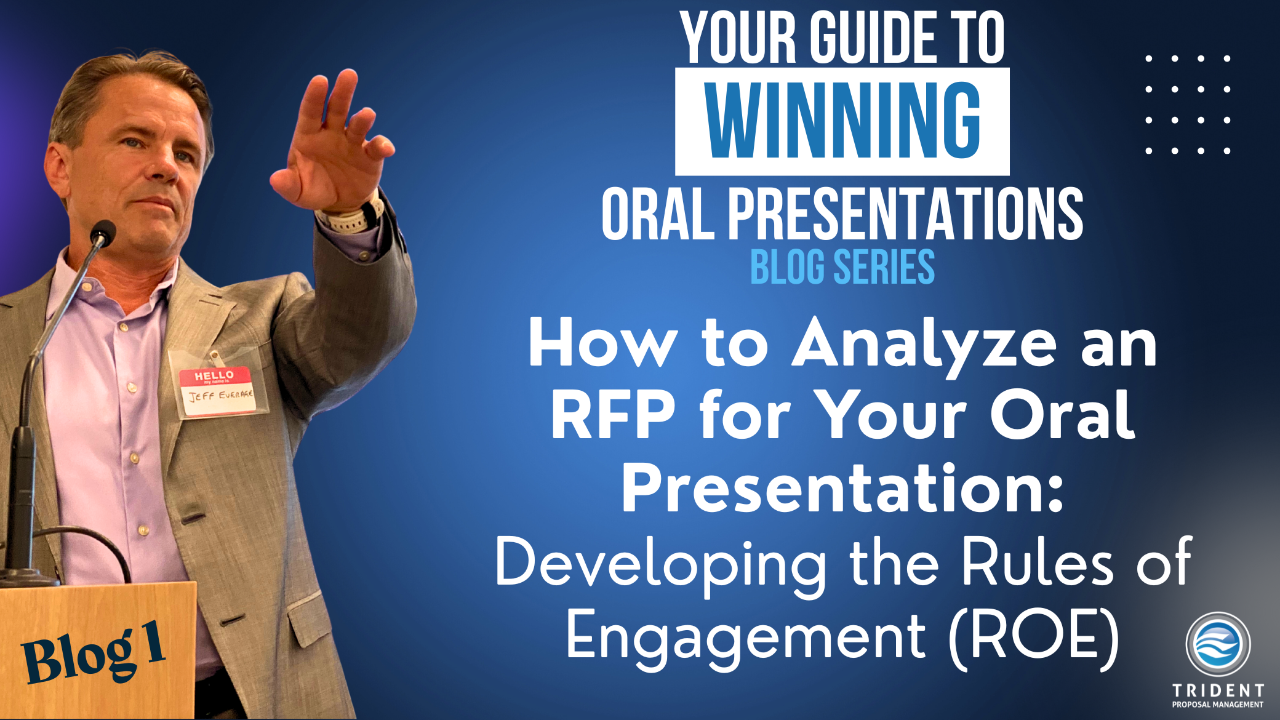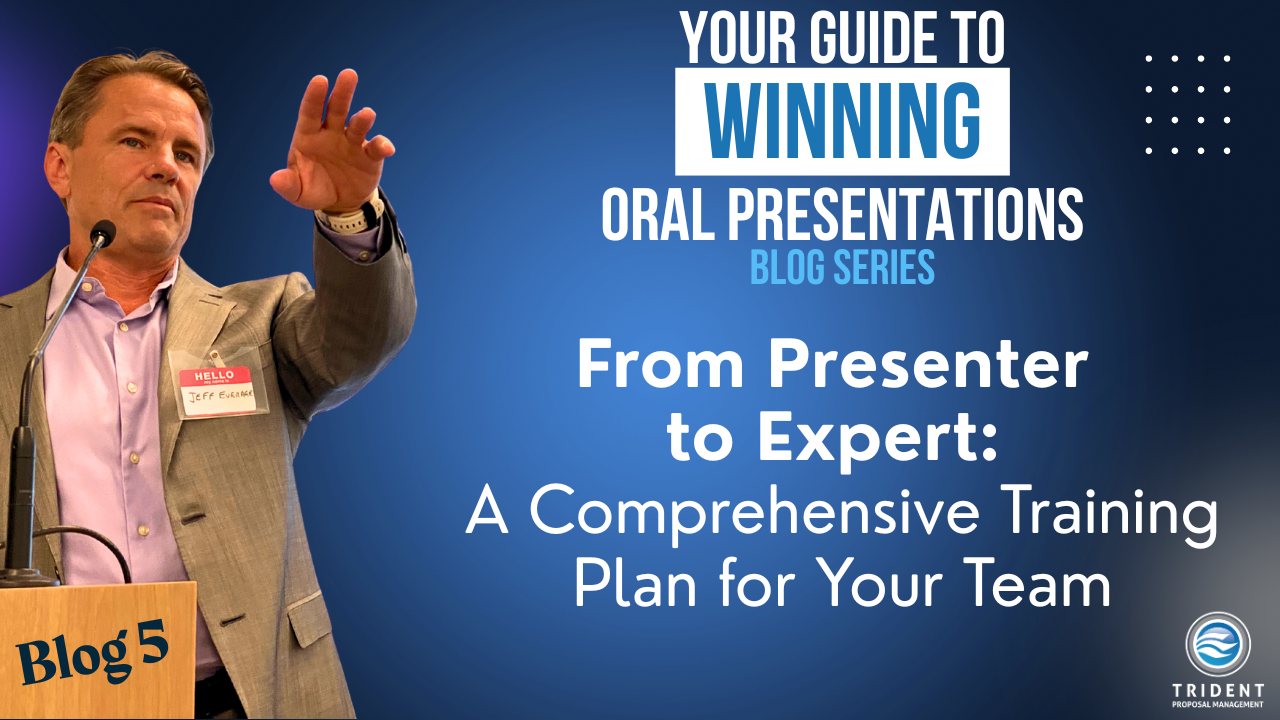How to Analyze an RFP for Your Oral Presentation: Developing the Rules of Engagement (ROE)
Nov 03, 2025
Reading Time: Approximately 7 minutes
In this first post of our oral presentation coaching blog series, we’ll start with the basics -- how to analyze the RFP and establish your Rules of Engagement (ROE), which forms the foundation for the entire proposal response process.
About Government Oral Presentations
A proposal presentation (also called an “oral presentation”) is when a business must present a portion or all of its proposal to the government through a live or video presentation. Oral presentations are governed by FAR 15 (see the original FAR 15.102; FAR overhaul 15.102 and FAR 15.105).
Proposal Presentations Are Often the Deciding Factor
Proposal presentations are often the deciding factor in determining who wins the contract. Most requests for proposal (RFPs) require a technical volume that outlines your approach to the work and a corporate experience or past performance volume that details your relevant work history performing similar work. (Trident Tip: A savvy contractor will build their proposal team to include subcontractors with relevant capabilities and experience so that the collective team can cover every part of the RFP.) Credible, competitive bidders will be able to provide a viable technical approach and strong examples of relevant experience, which means that when past performance and technical solutions are similar, the oral presentation tips the scales.
That’s why a disciplined analysis of the government RFP - especially Section L (Instructions) and Section M (Evaluation Criteria) - must be your first step. Launch your static proposal presentation by breaking down requirements and creating your detailed Rules of Engagement (ROE). This document is a blueprint that informs every downstream activity – from team selection to deck development to rehearsal and delivery. (Note: Depending on the type of solicitation you are responding to, there may not be a “Section L” and “Section M”, but there will always be equivalent sections that contain instructions and information about how you will be evaluated.) Once you locate the instructions for your oral presentation, you can build your ROE.
Trident Tip: Build your ROE in a Word document or Excel file. By creating a separate file, you’ll have a quick reference guide to easily find the exact language and referenced sections.
ROE: Guide and Guardrails
The ROE guides everything about your response: who you select, how you train, what words appear on slides, and where presenters focus. Do not rely on assumptions or “what worked last time” (even if you’re the incumbent) – base every choice on the specific RFP you’re responding to. Your ROE should include direct quotes and exact phrases from the RFP, with citations so the team knows precisely where to find the government’s source language if challenged (e.g., Section L, paragraph 1.1; Attachment C, Table C-1, Line 7).
You can build an ROE in three steps:
Step 1: Extract Requirements from Instructions
Review the RFP and dissect every instruction (“Section L”) regarding oral presentations. The instructions are your hard constraints and should form the baseline for your response format. Things that are commonly in the instructions include:
- Overall Time limits: Document any total presentation limits, Q&A duration, or restrictions on demos. Copy/paste these verbatim into the ROE. Remember, you want to cite the exact location.
- Presenter/Participation Requirements: Note whether specific personnel must present (e.g., “All Key Personnel must be presenters”), if there are limitations on the size of your presentation team (e.g., “No more than four presenters from the Prime plus one from each Subcontractor”), and whether you must have specific representation (e.g., “At least one presenter must be a corporate/executive representative”). Record the mandate exactly and annotate its potential impact.
- Slide/Format rules: Note directives about advance submissions, number of slides, format (font, type size, margins, etc.), or nuances such as “no animation.” Capture every rule word-for-word and cite the location.
- Venue and Logistics: Identify guidance on the location, virtual/in-person, government-provided equipment, etc.
- Content Structure: If the instructions give content order, agenda, or topics, those become your presentation outline. Sometimes this is provided during the down-select, which happens after you’ve likely already started your response. Follow the guidelines in the RFP and adjust if required.
If there are elements from the above missing, use this as an opportunity to ask clarifying questions to the issuing agency.
Step 2: Deconstruct the Evaluation Section – How You’re Scored
The evaluation section (“Section M”) lays out precisely how the Technical Evaluation Board (TEB) will evaluate you. This is key to keep in mind because it is the framework that evaluators will use to grade you. As you structure your response, keep in mind the Busy Grader Principle.
Busy Grader Principle: Assume that every evaluator is thinking, “Don’t make me think, don’t expect me to pay attention for long, and don’t make me do any extra work to evaluate your proposal!!!” (Note: we're not trying to offend anyone, but your team needs a quick way of staying oriented to the priorities and mindset of their audience). Build your ROE to make it easy for the evaluators to check their boxes and score you highly (Note: We cover the TEB in more detail in an upcoming blog).
- List all evaluation factors/subfactors: Cut and paste each element from the evaluation section into the ROE, breaking out every oral-specific line.*
- Extract scoring keywords/phrases: Highlight the exact words and phrases evaluators want to hear as identified in this section. Capture these in a “keywords” table for rehearsal and coaching. Additionally, there is often specific language in the rating methodology. Aim for their highest rating and keep these in mind for your overall approach.
- Identify scoring weights: Understand which items matter most in the overall score. If “Technical Approach” is identified as the area with the highest scoring potential, concentrate your oral presentation efforts on thoroughly addressing this section. Be sure to strictly follow all instructions provided in the RFP, ensuring that every directive and requirement - especially those related to “Technical Approach” - are clearly met and referenced in your presentation. Adhering to the guidelines is essential to maximize your score and demonstrate compliance to evaluators.
- Map requirements to slides/talking points: For every instruction and evaluation category, specify the relevant slide number and title, or indicate the designated speaker responsible for covering each topic.
The ROE should provide unambiguous mapping. Each slide, talking point, and proof element is directly connected to requirements and evaluation criteria.
*It’s important to note that the RFP or request may have oral instructions or details throughout the document. We say this a lot at Trident, but please read the solicitation (and attachments) in their entirety so you don’t gloss over an oral instruction or requirement that may not be within the requirement/evaluation sections. Ensure that you include all orals-related details in your ROE.
Step 3: Turn Analysis into a Living ROE
Each section of the ROE should directly reflect RFP markups and clarify:
|
Topic |
Description |
|
Timing |
Assign minute-by-minute durations for each section/person (e.g., Q&A: 20 min [Section L p.22]) that align with the presentation instructions. |
|
Mandatory personnel |
Specify precisely who must present. If the RFP does not specify, this is almost always a question for the government so that you can prepare early on. |
|
Themes and keywords |
Pull out the scoring language, keywords, phrases, required/banned terms that are in the RFP. In addition to being in the evaluation criteria (Section L), they may also come from the Statement of Work (SOW) or Performance Work Statement (PWS). * Trident Tip: Identify repetitive words and incorporate them into your ROE as keywords. |
|
Slide outline |
Draft an initial bullet list - one slide per required topic - using the exact RFP language for slide titles. These titles will be updated as you progress, but using the exact language provides you with the framework to address the requirement. |
|
Roles and Q&A |
Assign topics to presenters, clearly define who answers what, and flag sensitive/off-limits areas. |
|
Proof points |
What examples, metrics, or evidence must each slide/presenter provide? Annotate where the customer has asked for “quantifiable impacts” or “team experience.” |
Distribute the ROE to all participants, including presenters, slide developers, coaches, and proposal managers, and is referenced in every review and training. This is a living document. As amendments, Q&A, or down-select details are released, be sure to update the ROE and ensure everyone on the team is aware of updates and changes.
Example: Lifting Direct Language
If Section L says: "The Government will evaluate the oral presentation for clarity, technical understanding, and the ability of the proposed personnel to execute the plan," your ROE should include those exact phrases as core themes.
If Section M states: "Scoring is based on demonstration of project relevance, prior results, and risk mitigation," then “project relevance,” “prior results,” and “risk mitigation” must be repeated in the slides and talk track (speech).
Example annotation for your ROE:
- Slide 2 Title: “Project Relevance”
The phrase must appear on the slide and be stated verbally at least twice. Tie to Section M, p.19.
ROE Quick Checklist
As a company that provides compliance checks and oral presentation support, we know that checklists help drive progress. Below is a quick checklist based on the above guidance:
- All instructions (Section L) cut/pasted and assigned in the ROE
- All evaluation criteria (Section M), keywords, and grading weight included
- Slide outline and presenter roles mapped to the grading criteria
- Required RFP language and example types specified for both the deck and verbal delivery
- ROE distributed to all core team members before or during kickoff
Why Start Here?
Nothing else -- deck building, rehearsals, coaching -- works unless your ROE is fully grounded in the RFP language and structure. This transforms your oral presentation from a generic “talk” into a focused, criteria-driven win strategy.
The ROE document should be a living reference and study guide for the team throughout training, providing ongoing support and clarity. During ROE briefings, this resource becomes especially valuable, as it often prompts the presentation team to surface important issues and concerns - ranging from scheduling conflicts due to vacations or travel to uncovering significant gaps in knowledge - ensuring these challenges can be addressed proactively and collaboratively.
Additionally, as your oral presentation progresses, you’ll find that you’ll refer to your ROE again and again. When someone asks why you chose that word, why you included that graphic, or why your talk track addresses something atypical, your ROE (which is rooted in your RFP) will help remind you of the requirements in a succinct location.
Ready to Lock in a Winning Advantage?
A rigorous RFP analysis and comprehensive ROE are the first step. To ensure your team excels in the room, work with our experts who have led many teams to success in government orals.
- Explore our Oral Presentation Coaching services.
- Contact Us to transform your team’s prep and results.
Look for Part 2 of this series: Decoding the TEB: How to Win Over Government Proposal Evaluators
Original Content by Jeff Everage* and edited by Trident Staff
*Disclaimer
This blog post was created using original content from Jeff and run through AI for condensation. The original content used to form the prompt comes from Jeff’s orals coaching eBook.
Jeff is the President and Founder of Trident Proposal Management. As a GovCon Oral Presentation Coach for more than 15 years, Jeff has coached more than 100 teams to success. His insights into oral coaching, gained from the trenches of coaching, are designed to support you and your team in your efforts. As a Navy veteran, Jeff resides in Southern California and provides support to clients worldwide as part of our globally dispersed team.



